On finding niches for a dualmode transportation system in a large U.S. metropolis
by J.Schneider
September, 2005
Scope and Objectives
The objective of this paper is to describe a possible niche for a dualmode transportation system in a large
U.S. metropolitan area. Unless an
attractive niche for such a system can be defined that will attract broad
public support, it will have little chance of being given serious
consideration. It is likely that it will have to be justified as (1) being an
energy-efficient solution and one that can reduce the vulnerability of the
residents of suburban areas to possible gasoline shortages in the future and
(2) offering a fast and energy-efficient method of moving goods around the
metropolis.
Perhaps these two justifications would be sufficient to attract a broad base
of public support for building a new energy-efficient dualmode system that
would be of assistance in dealing with the adjustments required if gasoline prices rise and available supplies decline.
While there are many different dualmode concepts that have been formulated, this discussion will focus on only one type of system. We will assume a dualmode technology that enables automated operation of a specially-equipped vehicle on an electrified, exclusive guideway at speeds in the 60-120 mph range. Further it is assumed that the system is designed to handle both freight and people using a variety of vehicle types and sizes. All vehicles could also be operated on the conventional street system in a non-automated (manual) mode assisted by considerable in-vehicle capabilities (e.g. collision-avoidance radar) to help the driver with navigating, automated parking systems and other conventional requirements.
At present, there are three companies that are planning to meet most of these specifications. One is called RUF International, located in Denmark. Illustrations and details about it are available at http://faculty.washington.edu/jbs/itrans/ruf1.htm and at http://www.ruf.dk. Two other companies are planning to develop a dualmode system. MegaRail, is currently building a dualmode vehicle and test track in Texas. The other, called ULTra, has built three operating vehicles and a test track in Cardiff in the U.K.
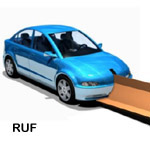
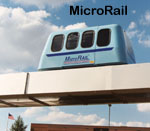
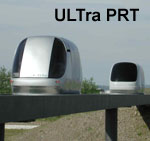
Serving the Future Suburban-to-Suburban Travel Market Niche
Given such a system, how might it be best deployed in a phased fashion to serve future travel needs within a major U.S. metropolitan area? Which travel markets could make the best use of such a technology, thereby insuring it would be well-patronized in its early years?
It is assumed that such a system would provide access/egress (A/E) facilities at a spacing of 10 miles, making it less attractive for short trips and more attractive for longer suburban trips. While the majority of person trips made in metropolitan areas today are quite short (i.e. less than 10 miles), we can expect more long trips in the future as metro areas continue to spread out, especially if very safe travel at higher speeds with no congestion, reduced energy requirements and less pollution are possible. Suburb-to-suburb trip patterns currently constitute the majority of daily person trips in metropolitan areas and it is likely that they will become an even larger proportion of daily person trips in the future – unless there is a severe oil shortage followed by a significant relocalization of activities within our cities as we try to adjust to a greatly reduced availability of motor fuels and their much higher prices.
The development of a dualmode transportation system might assist the residents of suburbs adapt to a severe or moderate oil shortage by providing a much more energy-efficient means of mobility within a very dispersed city. If we have a fairly gradual reduction in gasoline supplies with rising prices, then there may be some time available to build a dualmode system to help them adapt to this changed environment. If the guideways were low in cost, could be manufactured at multiple sites, assembled quickly from modular units and be easy to fit into existing urban environments, how should such a network be designed?
Many of our large metropolitan areas have freeway route structures that are radial to the historic downtown with one or more beltways forming concentric circles centered on the historic downtown. This route structure generates a convergence of traffic that often results in heavy congestion in the central area of the region and also in other non-central locations. Much of this traffic is not destined to the downtown but simply wants to get across the metropolitan area to a destination on the other side of the historic downtown. Some large metropolitan areas also have rail mass transit routes that are radial to the historic downtown and they provide some, but not much, relief from this convergence problem on the freeway system. Metropolitan bus systems have route structures that are much more diffuse but they too are often downtown-centric to a great extent and can contribute to the congestion caused by this converging route structure. None of these existing systems are well-suited to serve the growing suburb-to-suburb travel pattern that has become dominant (approximately 2/3rds of all daily person trips) in the past two decades. Most analysts believe this travel pattern will continue to grow and become even more dominant, as long as gasoline remains available at reasonable prices. If that is not the case, some significant adjustments in the quantity and patterns of travel will have to be made. It is suggested that the deployment of a dualmode network could assist such adjustments as well as helping to reduce gasoline dependency which would be beneficial even if a significant gasoline shortage does not occur in the near future.
Serving the Goods Movement Niche
A large component of the urban travel scene consists of truck traffic. A gasoline shortfall with higher prices will impact the ability of the trucking industry to maintain current practices and this is a second vulnerability that must be addressed. Data on goods movement patterns in a large metropolitan area is scarce to non-existent, but it is very visible and is often cited as a major reason for congestion and accidents on the urban freeway system. A dualmode system could be used to help maintain current goods distribution arrangements while providing more energy-efficient, faster and safer travel for small dualmode goods movements. It can be anticipated that a prolonged gasoline shortfall will lead to some relocalization of retail and other commercial activities which means that, to survive, some big box stores would have to be downsized and dispersed, requiring more frequent deliveries of smaller loads. Such relocalization would produce a greater need for small truck traffic in the future that could be served by a dualmode transportation network. A second reason why making sure that dualmode trucks traffic would be served is the "chicken and egg" problem. Getting a dualmode system started requires building both dualmode guideway and dualmode vehicles at the same time. Such a system would benefit from use by dualmode trucks and small transit vehicles in its early stages. This type of use would still allow plenty of room for personal dualmode vehicles (privately-owned or rented) as production and purchase levels are increased to significant levels.
A Though Experiment
What type of network structure would be more compatible with these two large travel markets? As a thought experiment, suppose one were to design a dualmode transportation network that has a rectangular grid structure and superimpose it on the existing freeway and mass transit (bus and/or rail) route structures. Suppose it had a route spacing of approximately 10 miles with A/E facilities approximately 10 miles apart.
Further suppose that it was not designed to directly serve clusters of destinations in the historic downtown or at other major activity centers but that it’s A/E facilities were located nearby, but not in, these existing employment/commercial clusters. Ideally, these high-density centers would be well-served by a circulation system that was well integrated with the dualmode A/E facilities, allowing vehicle interchanges and/or seamless (cross-platform) transfers. An example an appropriate circulation system would be a Personal Rapid Transit (PRT) system that could perform this function very well. Some examples are shown below, more details are available at: http://faculty.washington.edu/jbs/itrans/prtquick.htm. RUF International plans to provide a circulator service without the necessity of a vehicle change. Both MegaRail's MicroRail and ULTra also expect to provide this capability. Skyweb Express has no current plans to develop a dualmode capability as its vehicles must remain captive to the guideway.
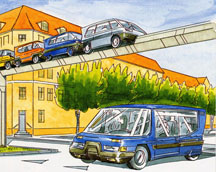

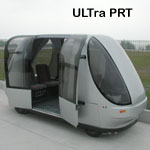

All of the dualmode vehicles should be designed so that they could make use of the existing freeway on-ramps or could be parked in automated parking facilities near mass transit stations so that a seamless transfer could be made to existing freeway, rail or bus modes as desired.
An Illustration of a Dualmode Grid-type Network
A metropolitan area like Houston, Texas, is approximately 25 miles in diameter so a Houston dualmode grid would probably consist of something like three N-S routes and three E-W routes and 16 A/E facilities, assuming a uniform 10-mile spacing. Below is a sketch of what such a hypothetical dualmode network might look like.

Its total one-way route mileage would be approximately 240 miles, or 480 miles for two-way guideways. It would also require 4 one-way, 8 two-way and 4 three-way interchanges to allow for changes in the direction of travel at the 16 A/E locations. The three-way interchanges would be the most complex, the others less complex but would have to be designed to allow for expansion at some later date. For an illustration of what a full two-way ( right, through) interchange might look like and how it would operate, see the excellent junction simulation program developed by RUF International, in Denmark, at: http://www.ruf.dk/files/index.htm (see the first one on the list). RUF International has also prepared a sketch of a more elaborate two-way junction that shows the considerable functionality of the concept, shown below.
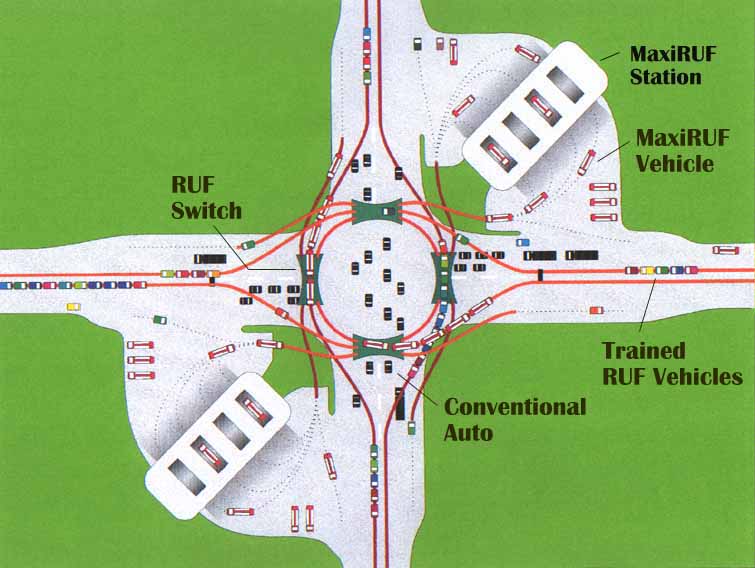
How Would It Be Used?
A dualmode grid network structure like this would be most likely to attract trips of more than 10 miles, origin-to-destination. Trips longer than this would take less time than now because of high speeds and no congestion delay and would be far safer and more reliable than conventional freeway travel. Such trips would use less energy (as compared with conventional autos and trucks) and the vehicles, using electricity for propulsion, would not generate pollution at the guideway. The hands-off drivers could use the commute time for a variety of purposes, if properly equipped with the necessary electronic devices.
The dualmode system might be used in preference to the freeway system in some cases as it could provide superior service even though the length of the trip might be somewhat longer. If that occurs, it could produce reduced volumes on some freeway segments, allowing them to be operated at higher speeds and volumes with less congestion. Reducing congestion would also increase the energy-efficiency attributes of the conventional highway system.
Given this system description and its supporting assumptions, would its benefits be likely to be greater than its cost? In addition to the cost of the physical facilities, this calculation should include some estimates of the costs of not being able to adapt quickly enough to keep the metropolis functioning at a reasonable level, assuming a medium-bad but long-term gasoline shortage. It is likely that a dualmode network could not be built fast enough to be useful in the event of a very-bad gasoline shortage that occurred swiftly. But, it could be very useful, perhaps even essential, if the fuel shortage were quite gradual and occurred over a period of a decade or more.
Likely Benefits
What likely benefits can be identified? Assuming that the people living and working in suburban areas could obtain or rent a suitable dualmode personal vehicle or have easy access to a vanpool-type dualmode vehicle, large numbers of suburban residents could maintain their functionality and reasonable levels of mobility living in an even more spread-out city for a few decades. Accidents and their many associated costs would be reduced. Air quality would be improved, assuming that the electrical energy needed for the system was generated by renewable or other relatively clean sources.
The sunken capital costs of the existing freeway and mass transit systems could continue to be used, perhaps at somewhat reduced levels, making them more efficient and useful for those still needing to use them. Some substantial cost-savings could be achieved if the functionality of today’s suburban areas was largely retained and enhanced in some respects, given a medium-bad gasoline shortfall. An increase in the frequency of goods movements within the metropolitan area could also benefit from the use the dualmode system at higher levels of efficiency than are now possible. This might also produce some reductions in truck traffic on the freeway system and reduce truck-induced congestion somewhat. Building such a system would generate a considerable amount of employment for several years but much of the employment would probably just be transfers from the highway construction industry. Since the safety of the dualmode system would have to be very high, some savings in the cost of accidents and insurance could be realized.
Likely Costs
What are some of the costs of this type of a dualmode system? Certainly, the capital costs of building and operating a fully-automated system of this type would be large. However, if a RUF, MicroRail or ULTra type guideway was employed, its cost probably would be less that conventional construction of the freeway type. IThey would also be easier to fit into an existing urban environment due to their smaller size.
The costs of producing and distributing the necessary electrical energy could also be large. The costs of designing and producing a variety of dualmode vehicles would be substantial, but probably not much greater than those currently incurred by the auto industry. Most of these vehicles would be purchased by individuals or groups, but early purchasers would also involve fleets of vehicles to be used by the trucking and transit industries, businesses, public agencies and car-sharing activities. Some public transit vehicles (smaller than conventional buses) could also utilize the dualmode network effectively as well. RUF International has designed the MaxiRUF vehicle to provide demand-responsive, dualmode service for up to eight passengers, as illustrated below.MegaRail's MicroRail will be able to physically connect its vehicles into a short train to serve larger numbers of patrons, both on the guideway and on conventional streets. MegaRail is also planning a dualmode vehicle that can be operated like a personal automobile. For additional illustrations, see a MegaRail overview graphic and a MicroRail tram and personal vehicle graphic.
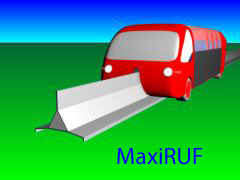
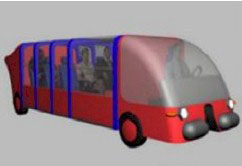
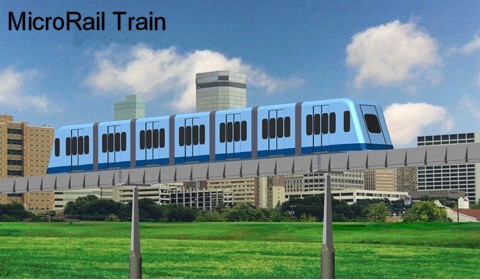
If the dualmode system was owned and operated by a public agency, it might have to be subsidized substantially in its early years as patronage is built-up. If it were investor-owned, it probably would need to be financed with tolls and bonds and might also require some public subsidy, especially in its early years. If patronage on existing mass transit facilities was negatively impacted, they might require increased levels of subsidy in order to continue to operate. Otherwise, cutbacks in transit service might be required,, making life more difficult those who are transit-dependent.
Next Steps
There are a number of questions raised by this thought experiment that can be defined at this point. None would be easily answered but they are amenable to analysis using conventional transportation planning tools. Some examples are as follow:
1. How extensive a network would need to be built for exclusive dualmode
system use in order to make a significant reduction in future levels of energy
use and congestion within an urban region?
2. Could such an exclusive dualmode network be able to make use of some
existing rights-of-way (e.g. urban arterials) so as to require lower cost,
relatively easy, new construction without adding more congestion to the
existing conventional freeway/arterial network?
3. What effect would the dualmode system be likely to have on recurring levels
of congestion (i.e. choke-points) on conventional (non-automated) freeways and
arterials?
4. How would congestion relief benefits be distributed among the personal and
commercial drivers of the dualmode-equipped vehicles and non-equipped
vehicles?
5. How difficult would it be to connect the dualmode system to the rest
of the roadway system (number and location of access/egress ramp connections)?
6. How difficult would it be to find routes, with minimal environmental impacts (e.g. noise) for the dualmode guideways and associate facilities in an existing urbanized area?
7. How would trucking managers and employees (e.g. Teamsters) view the benefits and costs of a dualmode system, given the emergence of a fuel shortfall and rising prices?
Finding niches for a new transportation mode that can compete
effectively and obtain broad public support is a daunting task. One can expect
vigorous opposition from those with heavy investments in conventional
transportation modes. But, a significant gasoline shortage with rising prices
may force some major adjustments to be made in the way we invest
transportation funds and operate/maintain existing systems. If dualmode
technologies are to have a role in assisting such adjustments, these and many
other questions need to be examined in the very near future.
Last modified: September 22, 2005